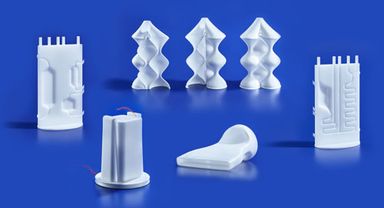What Are Bioceramics & How Are They Used?
Understanding the role and the extensive applications of bioceramics reveals a fascinating intersection of biology and engineering. These advanced materials have transformed various industries, from healthcare to aerospace, by offering unique properties that outmatch traditional materials. This exploration into bioceramics will uncover their definition, types, and the broad spectrum of applications that benefit from their distinctive characteristics.
What Are Bioceramics?
Bioceramics are ceramics specifically engineered for use in medical and biological environments. Characterized by their biocompatibility, they do not provoke an immune response when integrated into the body, making them ideal for a range of medical applications. The spectrum of bioceramics includes bioinert ceramics, such as alumina and zirconia, bioactive glasses and glass-ceramics that bond with bone, and resorbable ceramics that dissolve within the body over time.
These materials stand apart from traditional ceramics due to their ability to interact favorably with biological tissue, a property that makes them indispensable in the field of medicine. However, the scope of bioceramics extends far beyond healthcare, finding applications in areas as diverse as environmental engineering, aerospace, defense, and the automotive industry.
Applications of Bioceramics in Various Industries
Bioceramics have transcended their medical origins to play a vital role in several sectors. Here, we explore their multifaceted applications across different industries.
Biomedical Applications
- Bone Repair and Replacement: Bioceramics are used to manufacture prostheses and components for bone repair, offering durability and compatibility with human tissues.
- Dental Implants: They form the basis of many dental implants, providing a strong, bio-compatible foundation for artificial teeth.
- Drug Delivery Systems: Certain bioceramics can be engineered to release therapeutic agents directly at the site of implantation, enhancing the efficacy of treatments.
Environmental Applications
- Filtration and Purification Systems: Their porous nature makes bioceramics excellent filters, purifying water and air by trapping contaminants.
Aerospace and Defense
- Heat Shields: The thermal resistance of certain bioceramics makes them ideal for protecting spacecraft and missiles from extreme temperatures.
- Sensor Components: Bioceramics are used in sensors and other components that require materials capable of withstanding harsh conditions.
Energy Sector
- Fuel Cell Developments: Bioceramic materials contribute to the efficiency and durability of fuel cells, which are pivotal for clean energy technologies.
- Thermal Barrier Coatings: These coatings protect equipment from extreme temperatures, enhancing the longevity and safety of energy generation systems.
Automotive Industry
- Catalytic converter substrates for reducing emissions
- Sensors for vehicle management systems
- Wear-resistant parts in engines and brakes
- Thermal barrier coatings to protect against high temperatures
Beyond the Known: Expanding Horizons
Research and development in bioceramics are opening new doors every day, pushing the boundaries of traditional applications. Some emerging applications include:
- Electronics: High-performance insulators and substrates in microelectronics.
- Wear-resistant Coatings: For tools and machinery, extending their life and performance.
- Photocatalysts: In environmental cleanup efforts, breaking down pollutants under light.
3D Printed Ceramic Components: Revolutionizing the Field
The advent of 3D printing technology has ushered in a new era in the development of bioceramic components. This cutting-edge manufacturing process offers a slew of advantages for creating custom bioceramic parts, from intricate medical implants to components designed for extreme environments in aerospace and defense. The precision, customization capabilities, and speed of 3D printing stand out as transformative benefits, enabling the rapid prototyping of components that meet specific requirements with unprecedented accuracy.
Innovative Uses of 3D Printed Bioceramics
3D printed bioceramic components are finding their way into a range of groundbreaking applications across various sectors:
- Complex Medical Implants: Tailor-made implants that perfectly fit the patient’s anatomy, improving the success rates of surgeries and patient recovery times.
- Bespoke Dental Solutions: Custom dental crowns and bridges that offer a perfect fit and match the natural color of teeth, enhancing both function and aesthetics.
- Aerospace Components: Lightweight, heat-resistant parts for aerospace applications, where precision and durability are non-negotiable.
- Wearable Technology: Bioceramic components for wearable devices, combining durability with biocompatibility to enhance user comfort and device longevity.
- Energy Sector Innovations: Components for energy applications, such as solid oxide fuel cells, benefitting from the high-temperature resistance and durability of bioceramics.
Unlock New Engineering Possibilities with Smartech’s Ceramic Components
Smartech revolutionizes engineering solutions with its custom 3D printed ceramic components, leveraging a unique partnership with Steinbach’s Technical Ceramics department. The use of the Lithography-based Ceramic Manufacturing (LCM) method ensures these components are not just lightweight and heat-resistant but are crafted with unparalleled precision and detail. This advanced manufacturing process caters to a wide range of applications, from rapid prototyping to full-scale production, offering significant advantages:
- Precision: The LCM method produces components with unmatched accuracy, suitable for the most demanding applications.
- Speed: Accelerated development and production timelines drastically cut the path from concept to reality.
- Customization: Tailored solutions meet specific needs, enhancing both performance and compatibility.
At Smartech, we understand that stepping into the realm of ceramic engineering might seem like navigating uncharted waters, with concerns about the cost of technology and the expertise required. Let us allay those fears. With Smartech, you gain an ally who provides not only the technological capabilities but also the proficiency, without the formidable investment usually associated with such innovation. The future of engineering awaits, and with Smartech, you’re always one step ahead.
Elevate your engineering projects with Smartech’s precision ceramics. Discover how our solutions can expand your possibilities. Connect with us today!

Looking for More Information?
Check out our Resources or Contact Us
